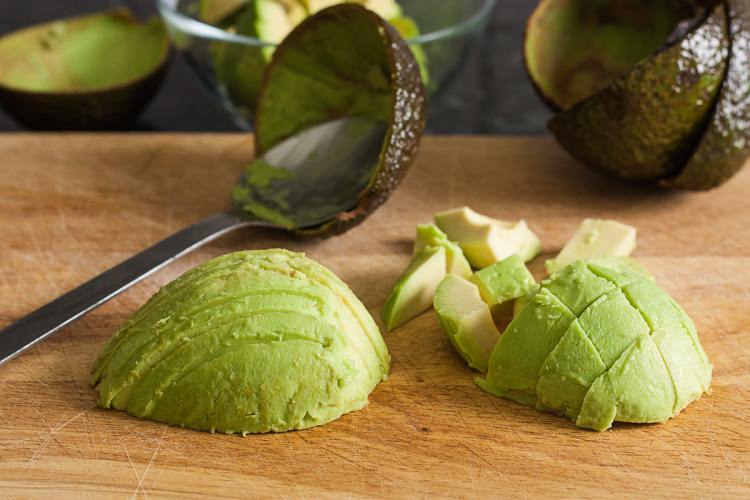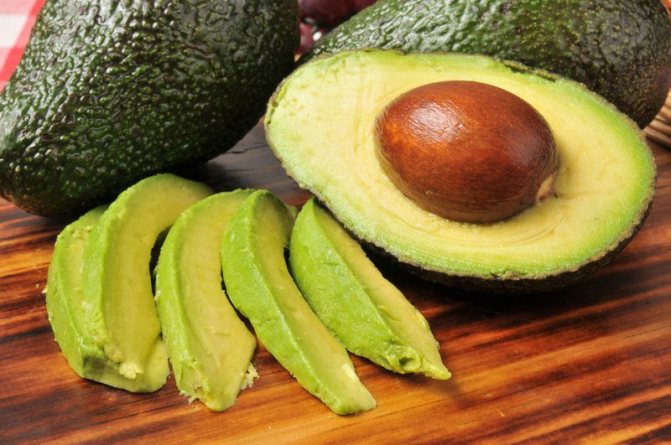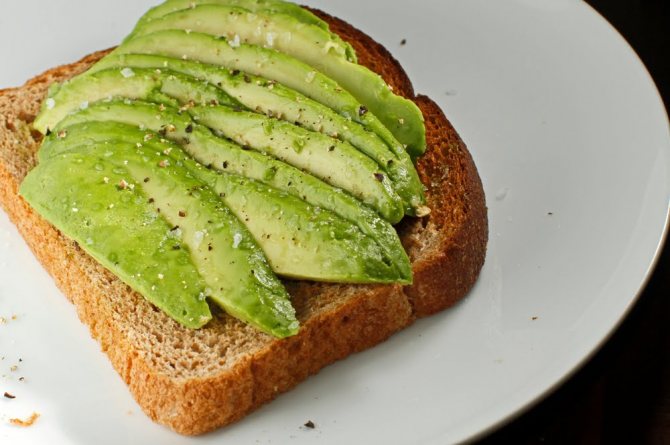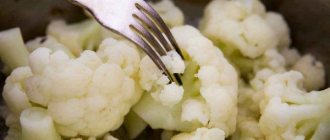Benefit
If you try this amazing fruit for the first time, you may confuse it with other products. This is a fatty fruit with creamy pulp. Initially, avocados began to be grown as a cultivated plant in Mexico. It grows on tall evergreen trees. The shape of the fruit can be round, pear-shaped or oval, depending on the variety, and the color of the peel can be green or brown-black.
Avocado has a number of beneficial properties that are indispensable for breastfeeding:
- restores and normalizes hormonal levels;
- improves sleep and relieves depression;
- restores proper metabolism, preventing obesity;
- favorable for the organs of vision;
- promotes the development of brain cells;
- provides women's and children's bodies with essential folic acid, which is involved in regenerative processes.
Avocado contains palmitic, oleic, linolenic acids, which have a positive effect on all organs and systems of the body of both mother and baby: cardiovascular, immune, digestive, reproductive. This exotic aromatic fruit restores sodium and potassium in the body, and also maintains the balance of acids, improves immunity and lowers blood pressure.
Benefits of the fruit
It is not for nothing that avocado is included in the diet of people who adhere to a healthy diet. In a small green fruit, nature has compactly placed a lot of substances important for our body:
- Avocado during lactation will provide the new mother’s body with healthy monounsaturated fatty acids.
- The fruit contains quite a lot of vitamins A, C, B, E, P and K.
- This fruit is rich in minerals necessary for mothers - potassium and calcium, iron and copper, sodium and manganese, as well as magnesium, which is necessary for the functioning of the nervous system.
With regular consumption of avocado during breastfeeding, the mother will quickly notice a positive effect that occurs due to the action of the vitamins and elements contained in the fruit pulp:
- The composition of the blood improves, its cells are renewed faster.
- The body's resistance to colds is noticeably enhanced.
- Supports heart function.
- The water-salt balance is normalized.
- The functioning of the digestive system is stabilized.
- The skeletal system is strengthened, the condition of hair and nails improves.
- Mental activity is stimulated.
The neutral taste of the fruit allows it to be used in vegetable and fruit salads with equal success. The main thing is to introduce avocado into your diet during breastfeeding without consequences. But is it possible to eat such a healthy fruit right away?
How does avocado affect breastfeeding?
Of course, when breastfeeding, many mothers try to eat familiar dietary products, fearing any exotic foods that could cause allergies in a breastfed baby. But already in the first month, you can first introduce a banana into your mother’s menu, and then after 3-4 months – our wonderful fruit.
[fm_test id=”2"]
Avocado is a source of important minerals:
- gland;
- phosphorus;
- sodium;
- magnesium;
- vitamins gr. B, RR, E, S, K;
- Omega acids.

Regular consumption of fruit in the absence of allergies brings undoubted benefits:
- cleanses the blood of harmful cholesterol, improves its composition and regeneration of blood cells;
- vitamin E prevents cellular aging and protects the immune system;
- polyunsaturated fatty acids prevent atherosclerosis and reduce cardiovascular diseases;
- potassium restores water-salt balance and supports heart function;
- Vitamin B2 improves blood circulation and prevents anemia after childbirth;
- helps cope with gastrointestinal disorders;
- acts as a source of healthy protein;
- serves as a decongestant and antiviral agent, especially during an exacerbation of influenza;
- used as a cosmetic product to improve the condition of a woman’s skin after childbirth;
- strengthens the skeletal system of both mother and baby;
- stimulates mental activity due to phosphorus content.

As you can see, avocados can be eaten while the baby is breastfed. Beneficial substances from the pulp of the fruit enter the milk, promoting the correct and harmonious development of the baby.
Useful properties and composition of avocado for breastfeeding
Avocado contains many useful microelements, among which are:
- dietary fiber;
- sodium;
- palmitic and oleic acid;
- iron;
- vitamins PP, A, B, C, K, E;
- folic acids.
Thanks to the listed microelements, the fruits have beneficial properties that have a beneficial effect on the body of young mothers and newborns.
For mother
Doctors advise young mothers to add avocado and various dishes prepared from it to their daily diet. The benefits of eating this fruit include:
- improving immune function;
- activation of brain activity;
- prevention of premature aging;
- increased performance;
- removal of cholesterol;
- elimination of signs of hypertension;
- increase in hemoglobin level.
For the baby
It is no secret that eating avocado has a beneficial effect on the health of not only the mother, but also her newborn baby. Regular consumption of fruits during breastfeeding has the following benefits:
- enrichment of the child’s blood with oxygen;
- strengthening the baby's hair;
- preventing the occurrence of anemia in infants;
- eliminating constipation and normalizing the functioning of the digestive system.
How to properly introduce avocado into your diet
It is worth adding such a unique fruit to the mother’s menu gradually, in small pieces, daily monitoring the baby’s reaction. It is better if he is already 3-4 months old. If a woman has gained extra pounds during pregnancy, she should not eat more than one avocado per day. Excessive consumption can cause obesity and allergies.
Avocado is included in many fruit salads, but each ingredient can be introduced gradually, starting with apples and bananas. And from 8 months, avocado can be given to the baby. The first portion of pulp for mom is a couple of pieces, the amount of which gradually increases day by day, unless negative manifestations appear.

If lactation proceeds without problems and there are no allergic manifestations, then avocados are supplemented with other healthy fruits. If a negative reaction occurs in a child or mother after feeding, avocados should be excluded from the menu, consult a doctor and be introduced again only after a couple of months.
Menu ideas
Avocado and butter paste goes great with many dishes. The fruits of the tropical tree are very nutritious. Also, their pitted and peeled pulp can be eaten raw. It tastes very pleasant and is suitable for all kinds of salads or fruit desserts.
Avocado will be a complete replacement for butter on your morning breakfast sandwiches. The pulp of the fruit is also combined with meat and fish, and it is added to soups.

The raw fruit has the highest concentration of nutrients. But before eating, the fruit must be washed well with water to wash away dirt and pesticides.
When choosing an avocado, its appearance is important. The peel of the fruit should be free of spots and dark spots, and when pressed, quickly restore its shape. An avocado that is too hard is unripe and tasteless.
Attention! Mom's menu includes only avocado pulp.
The leaves, seeds and peel are not suitable for consumption, as they contain harmful substances that can cause poisoning, vomiting and all kinds of allergic manifestations in mother and baby.
If you are allergic to citrus fruits or latex, then this fruit is introduced gradually and carefully.
As a result, it can be noted that avocado is a truly healthy tropical fruit, indicated for breastfeeding. Research conducted by scientists from many countries has shown that avocados do not contain any components that can cause harm during breastfeeding. The content of vitamins, minerals, beneficial acids and antioxidants helps to replenish the daily norm of nutrients for the body, helping the child to develop and grow properly.
81
Avocado recipes for nursing mothers
Recently, people are increasingly beginning to include avocado in their diet in combination with other products, so there are a considerable number of recipes with this exotic berry. Many of them are ideal for nursing mothers. To preserve the beneficial properties of avocado as much as possible, it is necessary to eat it raw and not subject it to heat treatment.
Avocado sandwiches
The easiest and most affordable way to eat avocado is to use it in sandwiches instead of butter.
To prepare a sandwich you need:
- Separate the pulp from the peel and pit.
- Place the pulp in a deep plate and gently mash with a fork until it becomes a paste.
- Spread a thin layer of avocado pulp onto a slice of bread or toast;
- You can put a piece of boiled chicken or turkey on the top of the sandwich.
Avocado sandwich - a healthy and satisfying breakfast for nursing mothers
It is also possible to prepare hot sandwiches with avocado. For this you will need:
- Two to three thin slices of avocado.
- A piece of bread.
- Hard cheese, finely grated.
- Finely chopped dill.
Place two slices of avocado on a slice of bread and sprinkle with grated cheese and dill on top. Place the sandwich on a baking sheet lightly greased with sunflower oil and place in the oven preheated to 180°C. Keep the sandwich for no more than 10 minutes until the cheese melts.
When exposed to heat treatment, avocados lose their beneficial properties.
Avocado fruit salad for nursing mothers
Since the list of fruits and berries during breastfeeding is quite limited, a young mother can prepare fruit salads only from approved products that have already been introduced into the diet and do not cause negative reactions from the baby’s body.
To prepare fruit salad you need:
- One apple.
- One banana.
- Half a medium sized avocado.
- Half a cup of corn flakes.
- A glass of natural yogurt.
Cut the fruit into small cubes, place in a deep plate and mix with yogurt. Consume immediately after preparation.
Avocado smoothie
Avocado smoothies are especially popular among women who are struggling with excess weight gained during pregnancy.
To make a smoothie you will need:
- Half a frozen banana.
- Half an avocado.
- A teaspoon of powdered sugar or granulated sugar.
- Half a glass of filtered or boiled chilled water.
Place all ingredients in a blender and blend until smooth. Drink the smoothie immediately after preparation.
If a woman and baby are not allergic to honey, you can replace sugar with half a teaspoon of honey.
Avocado smoothies should be consumed immediately after preparation.
After giving birth, I started eating avocados when the child was 5 months old. Before this, I already ate kiwi, bananas and apples. Therefore, I made smoothies and fruit salads with these three ingredients. I also added honey, which, as my mother told me, has a calming effect. It is especially useful to drink this “vitamin” drink before bed. Fortunately, neither I nor my child had any negative reactions to honey.
Like most fruits and berries, especially exotic ones, avocados can have both positive and negative effects on the body of a nursing mother and baby. But every mother has the right to decide what is best for her own body and the body of the developing child. The main principle when choosing food and creating a diet for every young mother is: “Do no harm!”
Avocado is an amazing exotic fruit that can easily compete with homemade butter or cheese in terms of the amount of healthy fats. But is avocado allowed while breastfeeding? Let's figure out whether a nursing mother can eat avocado and how to use it correctly.










